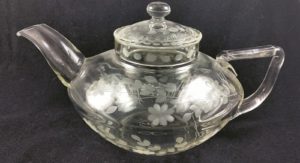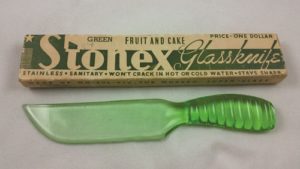The Rise of Kitchen Glass for Cooking
By Rosemary Trietsch
The term “Depression Era Glassware” usually evokes images of beautiful table settings in a rainbow of colors. But what very few people realize is that the earliest Depression glass produced was kitchenware and, that this lovely stuff so treasured today, was actually born out of necessity.
Prior to 1900, ceramic stoneware bowls and crocks were a staple in every kitchen. But stoneware can be awkward to use because it’s heavy and, by its very nature, prone to cracks, chips and crazing. Metal baking pans are lighter, but require more maintenance to keep free from rust and dents. And the long cooking time required for ceramic and metal meant using more energy resources. This was especially important to the patriotic spirit of the early 1900s, when the national focus was on conserving resources for the war effort.
In 1909, Corning Glass Works developed a new formula for a heat resistant glass specifically for use in railroad lanterns. (Lantern globes had a tendency to shatter when the warm glass was hit by rain and cold air.) This new glass was called Corning Non-Expansion glass and marketed as Nonex. It was a great success, and Corning quickly looked into ways to expand its use.
The “eureka moment” came while Corning scientist Jesse T. Littleton was having dinner with his wife, Bessie, who complained that her new ceramic casserole dish had shattered after only two uses. Jesse sawed off the bottoms of various Nonex bottles and brought them home for Bessie to try out. Her first attempt resulted in a sponge cake that cooked faster, more evenly and was easier to remove compared to metal or ceramic pans. Not only that, but the glass was lighter, more durable and more easily handled than the bulky ceramic stoneware. After a bit of fine tuning to the formula, Corning applied for a patent for their Pyrex “fire-glass” on July 10th, 1915. That same year, Pyrex was advertised in all the popular women’s magazines of the day – including Ladies Home Journal and Good Housekeeping – and Corning had a success on their hands.

Other glass companies were quick to enter this newly discovered cooking glassware field, but the H.C. Fry Glass Company expanded the market by taking cookware to a new level. “To be really up to date, you should use the same dish for cooking and serving – Fry’s Ovenware.” In 1921, they introduced their “Pearlware opalescent Ovenglass”, one of the most beautiful lines of kitchen glass ever produced. Early advertisements describe it as, “Moonbeams caught in a web of glass… There are soft, pearly tints, and glints of opalescence in this glass that make it attractive enough to look charming on your table.” This beautiful bakeware made an easy transition from oven to table, and was so popular that Fry added items such as meat platters, grill plates, butter pats, sherbets and snack tray sets specifically for table use.
Fry continued to expand the Pearl oven glass line adding kitchenware items such as measuring cups, reamers and storage containers, and once again, other companies followed suit. By 1929, the now fully automated American glass factories were producing complete lines of kitchenware in a variety colors. Hazel Atlas Glass Company advertised the first sets of mixing bowls and refrigerator storage jars in 1929 as “100% Automatic Machine Made Green Glass”. That same year, they also offered a line of kitchen glass in Platonite White which included shakers, drippings and storage jars, measuring cups and reamers.
Hocking Glass entered the kitchen glass market at about the same time, with a much more expansive line of green kitchen glassware. In addition to mixing bowls and refrigerator jars, Hocking produced canister sets, shakers, syrup pitchers, water bottles, reamers, measuring cups and multiple styles of refrigerator storage containers. (Note that Hockingís FireKing Ovenware line was introduced in 1941 – after Hocking had merged with Anchor Cap and Closure Company to become Anchor Hocking.)
Perhaps the most widely collected kitchen glass is the opaque wares that were produced by Jeannette Glass Company and McKee Glass Company in the 1930ís. Opaque kitchenware came in a variety of colors, from creamy custard to light blue to black. But the opaque green that has come to be called “jadite” in today’s collecting market remains the most popular. McKee called their opaque green “Skokie Green”, while Jeannette is the first company to use the name “Jadite”. Both companies used their jadite color to make full lines of kitchen glass including the usual – canisters, measuring cups, bowls, shakes and reamers – as well as the unique: water dispensers and rolling pins.
One of the most interesting things about collecting kitchen glass is searching for ordinary items that become extraordinary when they’re made of glass. A napkin holder is pretty ordinary; but a black glass napkin holder embossed “Property of Nar-O-Fold National Paper Napkin Company Chicago” is anything but. Drawer pulls and towel bars are commonplace items: red glass drawer handles and milk glass towel bars are not something you see every day. Sugar dispensers in glass are familiar items, but how often to do come across a “bullet” shaped one that fills from the bottom, or one that’s all glass with a vaseline glass screw in dispenser cap?

Like carbon steel, glass can be ground to produce a really sharp cutting edge. But glass has the advantage of not rusting or discoloring when it gets wet. Glass is also harder than carbon steel, so the edge stays sharp longer, and can easily be reground to razor sharpness if it should dull or chip. Glass knives range in size from 8 to 9 inches and were made in a variety of styles and colors. Finding the original box and paperwork with a glass knife is an extra bonus.
Kitchen glass is the only type of vintage glassware where pristine condition is not necessary. Collectors realize that mixing bowls and measuring cups were made to be used, and so a little roughness or signs of use are generally acceptable. (Note that the handle being broken off and glued back on is a sign of abuse not a sign of use.) But most people who buy Depression Era kitchen glass don’t consider themselves collectors. They don’t buy it to look at, they buy it to use because they realize that there’s nothing made today that works half as well or will last twice as long. After all, there’s just something fun about using a 100 year old glass pan to bake brownies!
Rosemary Trietsch is a show dealer and frequent lecturer on Depression Era glassware in the New York/Tri-state area. She is the owner of Just Glass (www.justglass.com) and proprietor of The Glass Cupboard (www.theglasscupboard.com). She welcomes your questions about glass and will answer selected letters in this column. You can submit your questions at www.justglass.com, and click on “Ask Just Glass”. Please submit a clear photograph of the piece along with a description that includes size, condition, and any identifying marks. You can mail your questions to: Rosemary Trietsch, c/o The Journal of Antiques and Collectibles, PO Box 950 Sturbridge, MA 01566. You may also email your inquiries directly to Rosemary at questions@justglass.com.
-
- Assign a menu in Theme Options > Menus WooCommerce not Found





Related posts: